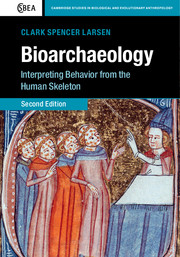Book contents
- Frontmatter
- Dedication
- Contents
- Preface to the Second Edition
- Preface to the First Edition
- 1 Introduction
- 2 Stress and deprivation during growth and development and adulthood
- 3 Exposure to infectious pathogens
- 4 Injury and violence
- 5 Activity patterns: 1. Articular degenerative conditions and musculoskeletal modifications
- 6 Activity patterns: 2. Structural adaptation
- 7 Masticatory and nonmasticatory functions: craniofacial adaptation to mechanical loading
- 8 Isotopic and elemental signatures of diet, nutrition, and life history
- 9 Biological distance and historical dimensions of skeletal variation
- 10 Bioarchaeological paleodemography: interpreting age-at-death structures
- 11 Bioarchaeology: skeletons in context
- References
- Index
- Plate section
1 - Introduction
Published online by Cambridge University Press: 05 April 2015
- Frontmatter
- Dedication
- Contents
- Preface to the Second Edition
- Preface to the First Edition
- 1 Introduction
- 2 Stress and deprivation during growth and development and adulthood
- 3 Exposure to infectious pathogens
- 4 Injury and violence
- 5 Activity patterns: 1. Articular degenerative conditions and musculoskeletal modifications
- 6 Activity patterns: 2. Structural adaptation
- 7 Masticatory and nonmasticatory functions: craniofacial adaptation to mechanical loading
- 8 Isotopic and elemental signatures of diet, nutrition, and life history
- 9 Biological distance and historical dimensions of skeletal variation
- 10 Bioarchaeological paleodemography: interpreting age-at-death structures
- 11 Bioarchaeology: skeletons in context
- References
- Index
- Plate section
Summary
Many thousands of archaeological human skeletons are currently housed in various institutional repositories throughout the world. Some of these collections are extensive: The Natural History Museum in London holds some 10 000 cataloged individuals, the Smithsonian Institution has at least 30 000 skeletons, and the Bavarian State Collection more than 50 000 sets of human remains (Loring & Prokopec, 1994; McGlynn, personal communication; Molleson, 2003). These and many other major collections around the world started during the nineteenth century, mostly for purposes of collecting crania and other remains for investigations of racial classification (Larsen & Williams, 2012; Little & Sussman, 2010) or as “curiosities” without any manner of context (Taylor, 2014). While these motives for collection have largely disappeared, these collections in Europe, North America, and elsewhere still provide today an essential foundation for the study of past human variation and evolution. The importance of the collections lies in the fund of biological information they offer for interpreting lifeways of past peoples and for developing an informed understanding of the history of the human condition generally.
One could argue that earlier generations of anthropologists may not have appreciated the enormous value of human remains for interpreting the past, especially in view of the high volume of excavated remains versus the remarkably low frequency of analysis and publication on those studied by biological anthropologists (Steele & Olive, 1989). Today, however, human remains have become a key element of archaeological research and have contributed to a burgeoning understanding of past population dynamics in general and the human condition in particular. This is especially the case for developing and testing hypotheses and drawing inferences about the human experience relating to diet, health, and lifestyle at all levels, from the individual (various in Stodder & Palkovich, 2012; and see Knudson, Pestle et al., 2012; Tiesler & Cucina, 2006) to large swaths of the globe (Steckel & Rose, 2002; Verano & Ubelaker, 1992; White, 1999). In addition, the study of ancient human remains is important in the ongoing discussions in anthropology about social organization, identity, and the linkages between health and gender and health and status (various authors in Gowland & Knüsel, 2006; Grauer & Stuart-Macadam, 1998; Knudson & Stojanowski, 2009).
- Type
- Chapter
- Information
- BioarchaeologyInterpreting Behavior from the Human Skeleton, pp. 1 - 6Publisher: Cambridge University PressPrint publication year: 2015

